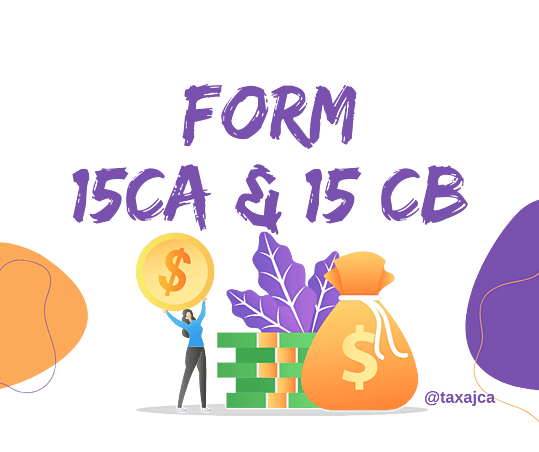Form 15 CA - CB for Foreign Remittances

- Form 15CA and 15CB will be NOT be required to be furnished by an individual for remittance, which does not require RBI approval
- List of payments of specified nature mentioned in Rule 37BB, which do not require submission of Forms 15CA and 15CB, has been expanded from 28 to 33 including payments for imports.
- Form No. 15CB will only be required for payments made to non-residents, which are taxable and if the payment exceeds Rs. 5 lakhs.
File your form 15CA-CB with help of Experts.
It usually takes 1 to 2 working days.
- Discussion about the matter with an Expert
- Preparation & Filing of Forms
- Business/Individuals making payments abroad.
- Upload documents on vault.
- Review the drafted forms by our experts.
- Filing of forms.
1. Name of the Remitter
2. Address of the Remitter
3. PAN of the Remitter
4. Principal Place of Business of the Remitter
5. E-Mail Address and Phone No. Of Remitter
6. Status of the Remitter (Firm/Company/Other)
B. Details of Remittee
1. Name and Status of the Remittee
2. Address of the Remittee
3. Country of the Remittee (Country to Which Remittance Is Made)
4. Principal Place of the Business of the Remittee
C. Details of the Remittance
1. Country to Which Remittance Is Made
2. Currency in Which Remittance Is Made
3. Amount of Remittance in Indian Currency
4. Proposed Date of Remittance
5. Nature of Remittance as Per Agreement (Invoice Copy, If any)
D. Bank Details of the Remitter
1. Name of Bank of the Remitter
2. Name of Branch of the Bank
3. BSR Code of the Bank
E. Others
1. Father’s Name of the Signing Person
2. Designation Of The Signing Person
Form 15CA-CB Unleashed here in this video!
Some more details about Form 15CA-CB
Some more details about Form 15CA-CB
15 CA: Payments made by a resident Indian to any non-resident has to be reported under the Income Tax Act. The idea behind the tax deduction at source & its reporting is to ensure collection of taxes on time. Form 15CA is a declaration stating that he has deducted the tax from payments so made to the non-resident.
15 CB: Unlike the first Form 15 CA, which is a declaration, this Form 15CB, is a certificate issued by a Chartered Accountant. This Certificate ensures that the provisions of the Double Taxation Avoidance Agreement and the Income Tax Act have been complied with in respect of tax deductions while making the payments. It includes the following:
👉 Details and nature of payment made to a Non Resident.
👉 Compliance with Section 195 of the Income Tax Act.
👉 Rate of TDS deducted.
👉 Applicability of the Double Taxation Avoidance Agreement.
Applicability of Form 15 CA & 15 CB
👉 If the amount of remittance is not chargeable to tax, then no forms are required.
👉 If the remittance is covered under a specified exemption list, then only Part D of the Form 15CA is to be submitted.
👉 Where remittance is less than Rs. 5 lakh in a particular financial year – Only Form 15CA – Part A to be submitted.
👉 Where remittance exceeds Rs. 5 lakh – Form 15CA – Part C and Form 15CB to be submitted.
👉 Where remittance exceeds Rs. 5 lakhs and a certificate under Section 195(2)/195 (3)/197 of the Income Tax has been obtained – Form 15CA – Part B to be submitted.
Parts of Form 15 CA
Procedure to file Form 15 CA & 15CB Online
Form 15 CA
- You can find the 15 CA forms on the Income Tax e-filing website.
- If A person is already registered on the Incometax site, he must log in with valid credentials.
- If he is not yet registered on the portal, he must click on the "Register" option on the page and then fill in all the necessary details and fields to complete the one-time registration.
- Once you're logged in successfully, click on the "e-file" option. Then "Prepare and Submit Online Form (Other than ITR)" button is to be selected.
- Next, select the option 'Form 15CA' and click 'Continue'.
- A pop-up window appears wherein Form 15CA is selected based on the most suited scenario upon submitting the form.
- The fields will need to be filled based on which Part of the Form 15CA is selected. The standard fields in Form 15CA include:
👉 Name of the Remitter
👉 Address details
👉 Contact information
👉 Residential status of the Remitter
👉 Name of the recipient of the Remitter
👉 PAN (if available)
👉 Details of remittance
👉 Details of TDS
👉 Verification of the form.
- Suppose the person is unable to finish the form immediately. In that case, there is a "Save Draft" option that throws a lifeline to avoid inconveniencing the person from filling up all the details again.
- Once you're done with the form, click "Submit".
- A pop-up window will appear with a "Success" message means the form is submitted successfully.
- View and Withdrawal of Form 15CA:
Form 15 CB
- The first task is the "Add CA" requisite.
- Under the "My Account" tab, select the "Add CA" option.
- The C.A. has to enter his Membership Number here.
- Form number 15CB is to be entered next.
- Since you've added the C.A. now, the C.A. himself will complete the rest of the process.
- The CA must be registered on the site as a C.A. user account.
- From the "Downloads" page, download Form 15CB Utility as the .xml file needs to be uploaded to successfully submit Form 15CB.
- Once downloaded, the .xml file has to be prepared offline and ready for upload.
- On the site, under the "e-File" option, click on the "Upload Form" button and enter the following details:
👉 PAN of the CA
👉 Form Name – 15CB
👉 Filing Type – Original
- Next, the prepared .xml file is to be uploaded and generated through the Utility.
- The DSC Management Utility has to be downloaded as well. This is beneficial in uploading the Digital Signature File for the submission to be complete in all respects.
- Click on the "Submit" button and await the Success page.
- View the Form:
- Once the Form 15CB has been uploaded and successfully submitted by the C.A., the assessee may then login and view the Form by selecting the "For Your Information" button under the "Worklist" tab.
- The Form status will be displayed as the case progresses.
The submission of forms such as these, in reality, aren’t as complicated and tedious as they are normally believed to be. Moreover, the option of withdrawing the form presents the opportunity to retract the form when necessary.
Here are the full details
A person responsible for making a payment to a non-resident or a foreign company has to provide the following details –
When payment made is below Rs 5 lakh.
For such payments, information is required in Part A of Form 15CA
👉 In the following cases, no submission of information is required
An individual makes the remittance, and it does not require prior approval of Reserve Bank of India [as per the provisions of section 5 of the Foreign Exchange Management Act, 1999 (42 of 1999) read with Schedule III to the Foreign Exchange (Current Account Transaction) Rules, 2000]
There are following types of Remittance where No 15 CA CB is Required
There are following types of Remittance where No 15 CA CB is Required
2. Indian investment abroad -in debt securities
3. Indian investment abroad-in branches and wholly owned subsidiaries
4. Indian investment abroad -in subsidiaries and associates
5. Indian investment abroad -in real estate
6. Loans extended to Non-Residents
7. Advance payment against imports
8. Payment towards imports-settlement of invoice
9. Imports by diplomatic missions
10. Intermediary trade
11. Imports below Rs.5,00,000-(For use by ECD offices)
12. Payment- for operating expenses of Indian shipping companies operating abroad.
13. Operating expenses of Indian Airlines companies operating abroad
14. Booking of passages abroad -Airlines companies
15. Remittance towards business travel.
16. Travel under basic travel quota (BTQ)
17. Travel for pilgrimage
18. Travel for medical treatment
19. Travel for education (including fees, hostel expenses etc.)
20. Postal Services
21. Construction of projects abroad by Indian companies including import of goods at project site
22. Freight insurance – relating to import and export of goods
23. Payments for maintenance of offices abroad
24. Maintenance of Indian embassies abroad
25. Remittances by foreign embassies in India
26. Remittance by non-residents towards family maintenance and savings
27. Remittance towards personal gifts and donations
28. Remittance towards donations to religious and charitable institutions abroad
29. Remittance towards grants and donations to other Governments and charitable institutions established by the Governments.
30. Contributions or donations by the Government to international institutions
31. Remittance towards payment or refund of taxes.
32. Refunds or rebates or reduction in invoice value on account of exports
33. Payments by residents for international bidding.

